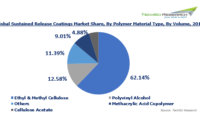How are Barrier Resins Formulating a Phenomenal Growth in US?
Product Overview:
Barrier Resins are best defined as the plastic precursors which are tailored for utilization across packaging application as they can restrict the entry of air or moisture into the container, jar, bottles or any other kind of rigid structure. Ethylene vinyl alcohol (EVOH), Polyvinylidene chloride (PVDC), Polyethylene Naphthalate (PEN) and Nylon 6 are some of the common synthetic barrier resins used by the packaging manufacturers worldwide. However, the increasing penetration of biological barrier resins such as Polylactic Acid (PLA), Poly Hydroxy Alkanoates (PHAS), Polybutylene Succinate (PBS), etc. is further advancing the growth in the Global Barrier Resins Market.
Country Insights:
The United States is a growing market for FMCG and consumer packaged goods, which is primarily driving the demand for barrier resins in the nation. The rising applications of barrier resins in consumer goods segment and market expansion are anticipated to propel the consumption of barrier resins, significantly through 2026.
US Household Consumer Expenditure, By Sector, 2016

Food Packaging Remains the Chief Driving Force for Barrier Resins in US: The consumers in the American nations are increasingly growing fondness for products featuring health and wellness along with quality. The barrier resins possess excellent oxygen barrier properties and aid in the preservation of natural taste, freshness and flavor of the stored food content. As a result, the barrier resins are proving extremely useful in the reducing food wastage by extending the shelf life of the packaged food items. As per the Association for Packaging and Processing Technologies (PMMI), the food packaging industry of the United States is projected to grow at a steady pace, witnessing a CAGR of 2.9% during 2017-22. The growing concept of convenience food across the nation due to the hectic living styles of population is expected to boost the food packaging sector, subsequently influencing the barrier resins market as well.
United States Flexible Packaging Market Share, By End User Industry, By Value, 2016

Source: Flexible Packaging Association
The food packaging accounts for a major share in the barrier resins market owing to the functional properties such as high clarity, light-weight, enhanced impact resistance and are going to remain the preferred choice of consumers to pack meat products, frozen or refrigerated beverages, chilled delicacies, etc. across the country.
Innovations and Technological Developments to Replace Metal & Glass Packaging:
In addition to food packaging, the other applications of barrier resins include packaging of critical pharmaceutical drugs & formulations, toxic and corrosive liquid chemicals, cosmetic preparations, etc. In 2017, the Dow Chemical company (now DowDuPont Inc.) announced the launch of barrier adhesive ADCOTETM L86-500 which features reduced packaging cost along with excellent recyclability and extended shelf-life of food packaging. With the launch of this innovative barrier resin, the company is aiming to substitute PET, metallized and aluminum-based packaging from the US CPG market.
United States Packaging Market Share, By Type, By Value, 2016

Focus on Biomass Balance is offering an exclusive opportunity for US Barrier Resins Manufactures:
The demand for sustainable solutions and recyclable plastic products in the US is fostering the growth of biological barrier resins at a modest pace. For instance, US based NatureWorks LLC is engaged in the production and marketing of Ingeo PLA resins which is approved by government agencies for applications involving direct food contact.
Conclusion:
In conclusion, the Global Barrier Resins market stood at USD1.98 Billion during 2016 and is projected to reach nearly USD3.52 Billion by the end of 2026, showcasing growth at a CAGR of 5.94% during the forecast period. The growth in the global barrier resins market can be attributed to the spurring demand for best quality packaged products in food & beverage and pharmaceutical industry. The ability of barrier resins to protect medical supplies and food items from exposure to light, moisture, oxygen and contaminants is primarily driving the global barrier resin market. In addition to this, the barrier resins can be extruded into bottles, sheets, films, etc. contributing to the efficient and safe storage & transfer of packaged goods, which would further escalate the global barrier resins market through 2026.
Request for Sample Report Today!
Related Posts

Top Investment Pockets in US Polycarbonate Industry

Europe to Dominate Montan Wax Market During Forecast Period

